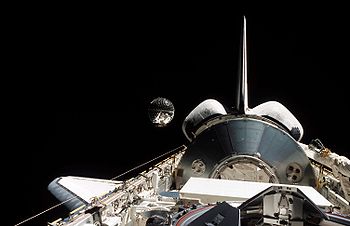
STARSHINE
Encyclopedia
The STARSHINE series of three artificial satellite
s were student participatory missions sponsored by the United States Naval Research Laboratory
(NRL).
The surfaces of these satellites were nearly covered with small mirrors polished by students for ground-based visual observation in twilight. Small retroreflectors were also being placed on the surface to support laser ranging. NRL has organized student-observing activities around the world to participate.
STARSHINE-2 and -3 also had a system to spin the satellite to improve the flash rate and included a few laser retroreflector
s to introduce the students to satellite laser ranging
.
The satellites were built from spare flight hardware. Students participated by polishing the mirrors used on the satellites.
 The STARSHINE launches were considered launches of opportunity; STARSHINE-1 was launched June 5, 1999 from the Space Shuttle
The STARSHINE launches were considered launches of opportunity; STARSHINE-1 was launched June 5, 1999 from the Space Shuttle
Discovery
on STS-96
, STARSHINE-3 launched on September 29, 2001 as part of the Kodiak Star Athena I
mission, and STARSHINE-2 launched December 5, 2001 from the Space Shuttle Endeavour
on STS-108
.
Satellite
In the context of spaceflight, a satellite is an object which has been placed into orbit by human endeavour. Such objects are sometimes called artificial satellites to distinguish them from natural satellites such as the Moon....
s were student participatory missions sponsored by the United States Naval Research Laboratory
United States Naval Research Laboratory
The United States Naval Research Laboratory is the corporate research laboratory for the United States Navy and the United States Marine Corps and conducts a program of scientific research and development. NRL opened in 1923 at the instigation of Thomas Edison...
(NRL).
Satellite description
STARSHINE-1 was a spherical satellite that carried nearly nine hundred small mirrors polished by students from around the world. Once launched, the network of over 20,000 students from eighteen countries tracked the satellite through the glinting of sunlight off the mirrors and networked the data collection over the Internet. The students used the observations to calculate air drag, solar activity, and other orbit related properties.The surfaces of these satellites were nearly covered with small mirrors polished by students for ground-based visual observation in twilight. Small retroreflectors were also being placed on the surface to support laser ranging. NRL has organized student-observing activities around the world to participate.
STARSHINE-2 and -3 also had a system to spin the satellite to improve the flash rate and included a few laser retroreflector
Retroreflector
A retroreflector is a device or surface that reflects light back to its source with a minimum scattering of light. An electromagnetic wave front is reflected back along a vector that is parallel to but opposite in direction from the wave's source. The device or surface's angle of incidence is...
s to introduce the students to satellite laser ranging
Satellite laser ranging
In satellite laser ranging a global network of observation stations measure the round trip time of flight of ultrashort pulses of light to satellites equipped with retroreflectors...
.
The satellites were built from spare flight hardware. Students participated by polishing the mirrors used on the satellites.
Launches

Space Shuttle
The Space Shuttle was a manned orbital rocket and spacecraft system operated by NASA on 135 missions from 1981 to 2011. The system combined rocket launch, orbital spacecraft, and re-entry spaceplane with modular add-ons...
Discovery
Space Shuttle Discovery
Space Shuttle Discovery is one of the retired orbiters of the Space Shuttle program of NASA, the space agency of the United States, and was operational from its maiden flight, STS-41-D on August 30, 1984, until its final landing during STS-133 on March 9, 2011...
on STS-96
STS-96
STS-96 was a Space Shuttle mission to the International Space Station flown by Space Shuttle Discovery, and the first shuttle flight to dock with the International Space Station. The shuttle carried the Spacehab module in the payload, filled with cargo for station outfitting...
, STARSHINE-3 launched on September 29, 2001 as part of the Kodiak Star Athena I
Athena I
The Athena I, known as the Lockheed Launch Vehicle at the time of its first flight and Lockheed Martin Launch Vehicle at the time of its second flight, is an American small expendable launch system which was used for four launches between 1995 and 2001, and which is scheduled to return to service...
mission, and STARSHINE-2 launched December 5, 2001 from the Space Shuttle Endeavour
Space Shuttle Endeavour
Space Shuttle Endeavour is one of the retired orbiters of the Space Shuttle program of NASA, the space agency of the United States. Endeavour was the fifth and final spaceworthy NASA space shuttle to be built, constructed as a replacement for Challenger...
on STS-108
STS-108
STS-108 was a Space Shuttle mission to the International Space Station flown by Space Shuttle Endeavour. Its primary objective was to deliver supplies to and help maintain the ISS....
.
Reentry
Starshine 3 reached a fiery end in the Earth's upper atmosphere on January 21, 2003. It had made 7434 revolutions around the earth since its launch.See also
- LAGEOS (Laser Geodynamics Satellites)LAGEOSLAGEOS, or Laser Geodynamics Satellites, are a series of scientific research satellites designed to provide an orbiting laser ranging benchmark for geodynamical studies of the Earth...
-- a series of scientific research satellites designed to provide an orbiting laser ranging benchmark for geodynamical studies of the Earth

